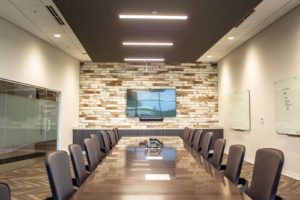The Right Office Space Can Help Your Employees Be Even More Amazing
The rise of flexible working, mobile working and the increased pace of workplace dynamics have dramatically changed the look of office spaces. Most have evolved from private offices and cubicles to unique spaces designed to maximize productivity.
The Gensler U.S. Workplace Survey 2019 stated that “today’s workplace is an ecosystem, and the best workplace experiences are built on variety, choice, and autonomy. Providing a great workplace experience also yields direct business performance benefits. Great workplaces create more engaged employees; and more engaged employees are the key to business productivity and profit.”
So, what kind of space does your company need to improve productivity and help your employees be as be as amazing as possible? It really depends on your industry, employee preferences and job functions. Dan Zakai, CEO and co-founder of Mindspace, suggested that while a more collaborative team might perform well in an open layout, many employees benefit from some sort of privacy, like the addition of private offices and other privacy solutions (i.e. phone booths and one-on-one rooms).
- photo by Stephanie Mader
- photo by Stephanie Mader
- photo by Stephanie Mader
When deciding on your office design, it is important to consider more than just cost or personal preferences. Private offices and open office floor plans each have pros and cons that can affect employee productivity, job satisfaction and work-life balance. According to the Gensler survey, “people prefer open environments with ample on-demand private space to support individual, focused work, but very few say they would prefer a totally private environment. And when rating what constitutes the ‘best’ workplaces overall, ‘team building and collaboration’ is the highest-ranked aspect of a great workplace.
While few employees prefer a “totally private environment,” many employees in open offices have a need to “seek refuge” and find quiet spaces where they can focus on a task or shut out the noise. Often, these individual employees are camping out in meeting rooms.
A study conducted by Density found that “just one person was using meeting rooms 36 percent of the time. It also found that 40 percent of meetings had between two and four people; and the capacity of smaller rooms was exceeded twice as often as rooms designed for five to seven people.”
Considering the inefficient use of space and cost of regularly using large meeting rooms for one or two employees. it may seem logical to shrink their size and number. But it’s not that simple. If you want your employees to be as productive as possible, you need to monitor and measure how people in your company use space. Fortunately, there are new advances in sensor technology that indicate how every room in a building is used without collecting any personally identifiable information or otherwise raising privacy concerns.”
Office hoteling is one way companies are adapting to the work preferences of their employees. Typically, this is reservation-based style of office management where employees schedule their use of workspaces. Given that nearly 90% of the U.S. workforce say they would like to telework at least part time, it’s a good model to ensure fair access to office resources, encourage greater collaboration and optimize space.
Micro offices or “phone booths” are another way to offer more efficient space for employees to go for privacy. Unlike most cubicles, which house one employee daily, phone booths are temporary spaces, meant for a few hours of work at a time. They can be a good and relatively low cost retrofit option as they are often available as a modular office furniture product which can be placed in areas of need and moved when needs change.
“Every company is different, so there is not one single solution to creating an office environment where people do their best work,” said Todd Greenwald, Compass Properties President. “The key is to observe and track the way your employees are using space, then adapt the space to meet their needs. It’s not just about making employees happier; it can also helps your company be more productive and profitable.”



